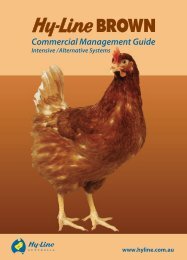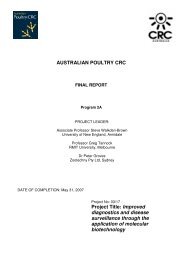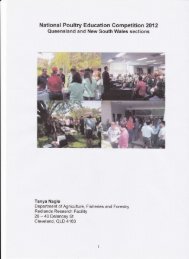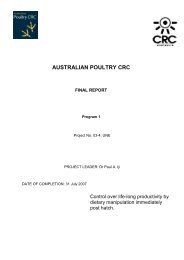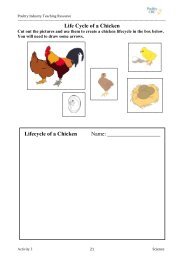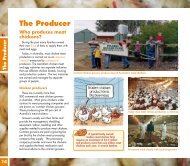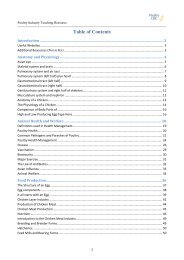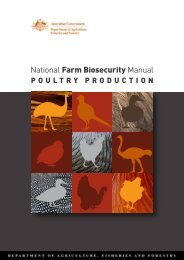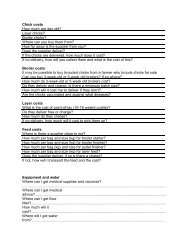AUSTRALIAN POULTRY CRC - Poultry Hub
AUSTRALIAN POULTRY CRC - Poultry Hub
AUSTRALIAN POULTRY CRC - Poultry Hub
- No tags were found...
You also want an ePaper? Increase the reach of your titles
YUMPU automatically turns print PDFs into web optimized ePapers that Google loves.
Faecal samplesFaecal samples were collected to determine parasite burden including worm burden and coccidiaoocycst counts per gram using methods described by Sloss et al. (1994) pp 9 and 79-87 (Figure 3).Figure 3: Collection of faecal samples for determination of parasite burden.Necropsy©The State of Queensland (DPI&F) 2007All dead birds from the survey shed were collected, recorded, labelled and sent for gross pathology forthree months. Farms were provided with freezers to store dead birds and were required to record dateof mortalities and label carcasses for identification (appendix H). All birds collected were delivered tothe pathology lab where the cause of death was identified (appendix I). The necropsy included thebody weight of the bird and an examination of the overall condition, as well as external and internalobservations. The tentative diagnosis was based on crucial clinical macroscopic lesions on organs.Microbiological samples are not recommended for birds that are found dead for more than 3-6 h.Given that, the majority of dead birds submitted for post mortem examination showed lesions ofreproductive tract such as oophoritis, salpingitis, egg peritonitis, salpingoperitonitis, and impactedoviduct, a follow-up investigation was undertaken to find a relationship between pathology findingsand possible bacterial implications.For the follow-up investigation, live birds showing similar symptoms to pilot trial or morbid-lookingbirds were sacrificed and examined. Microbiological samples were taken from all birds showingreproductive tract problems. The bacteriological examination followed the methodology adopted from“A laboratory manual for the isolation and identification of avian pathogens” 4th Edition published byThe American Association of Avian Pathologists (Swanye et al., 1998). Samples from liver, spleen,ovary, oviduct, intestinal content, and cloacae were collected aseptically and plated on nonselective(Columbia blood agar) and selective plating media (MacConkey agar, chromogenic Salmonella,chromogenic E. coli etc.). The plates were incubated at 37±0.5ºC overnight. At least three wellseparated colonies per plate were selected for transfer to more selective plating media.Bacterial isolates were identified by growth requirements, colony morphology, and cell morphologyand staining characteristics (see Appendix J). As Gram positive cocci were the most abundant isolatefurther tests were conducted for this isolate. S. aureus is fermentative for manitol, therefore, Grampositive cocci were further transferred onto a selective medium inhibitory for Gram negative bacteriasuch as Manitol Salt Agar (MSA) plates. This was also needed for differential recovery of isolates. Toconfirm the presence of coagulase positive or coagulase negative staphylococci and furtherdifferentiate S. aureus from other Staphylococcus sp, isolates were tested for coagulase reaction(Staphytect Plus; Oxoid). No further identification/typing was made for S. aureus and/or other isolates.10



